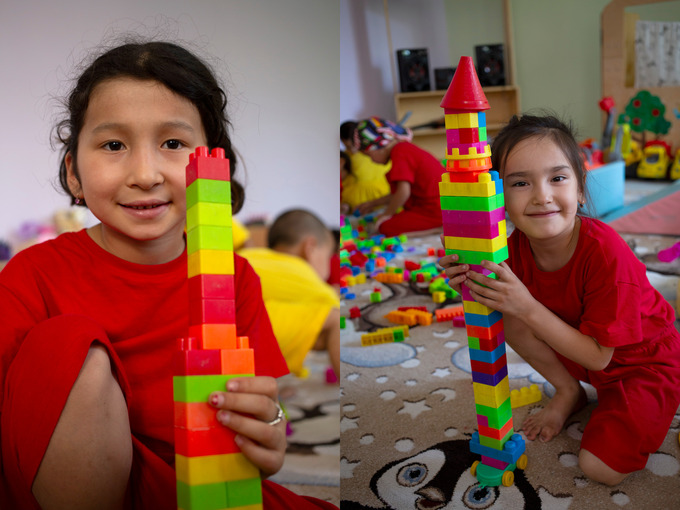O’zbekiston village, Turakurgan district, Namangan region. Here in the land of ancient towers — minoras, the race for building the biggest, tallest and most colourful tower is on! Shabnam (6 years old) goes against Imona (6), and it looks like the latter is winning.
 Shabnam and Imona. Photo by UNICEF.
Shabnam and Imona. Photo by UNICEF.
Shabnam is not perturbed. She is calm, careful and takes her time to finish the task at hand. She loves building blocks and the care in which she is constructing her tower bears testimony to her earlier assertion.
Shabnam is thoughtful yet witty. When her best friend Rukhshona (6) plays the lead in the traditional fable ‘Bogirsok' and is charming everyone, she is the only one who reminds the fox to “eat” the clever Bogirsok. Shabnam is a delight, smart, playful and in this room, among her peers, the young girl is thriving.
This was not always the case.
A few years ago, there was no preschool centre, in O’zbekiston village, a remote village in Turakurgan district, Namangan region. Here most parents are simple farmers, mainly subsistence farmers and Shabnam, remembers lengthy days spent at home, with little to do.
“I was just sitting at home. It was so boring. Now I come to school, I play with my friends, I love writing, playing with blocks and Lego is my best” says Shabnam.
Shabnam is not alone, like most of her peers here, before this centre, there was limited early stimulation.
She is part of a group of 20 pupils, that come to this “alternative” preschool in the morning, another group of around 20 comes in the afternoon. The preschool was allocated space in a wing of a local tertiary institution in the district. Unlike most children I see in Uzbekistan, these are simple children, devoid of the usual ribbons and frills many of their better off peers have. The red and yellow uniform outgrows some, but all of them wear it with pride.
The children revel in their moments in their classroom — the puppet show, the drama and the music.
This interaction is priceless, stimulating these young minds through play and emphatically laying the foundation for Uzbekistan’s human capital.
These humble moments are part of the unfolding education triumph in Uzbekistan.Cognizant that the first five years of life are the fastest period of human growth and development, as 90% of a person’s brain development occurs by the age of five, the country has made decisive investment in the early years. Evidence has shown that such investment for most vulnerable children, helps break the cycle of poverty, addresses inequality and will boost future productivity.
Unprecedented political will has seen enormous public resources ploughed into preschool education. National investment in Early Childhood Education, saw a threefold increase since 2018, reaching over 20% of the public education budget at one point.Consequently, enrollment rose to over 69% in 2022 as compared to 30% in 2017.
Further, alternative models including private-public partnership were introduced leading to over 21,600 new preschool facilities established since 2018;
To reach the last mile and bridge the equity gap, alternative ECD centres such as Shabnam’s are scattered around the country in places where there was no access before, often where communities could not afford such a service and importantly, offering a foundational social safety net for some of the most vulnerable families in Uzbekistan. Evidence shows that early interventions can help children overcome disparities and increase adult wages later in life.
It is working.
Children like Shabnam get to access early child stimulation and learning for free. These are children that often would not have the luxury to access these facilities.
Following the introduction of alternative centers such as this one, preschool is reaching some of the most vulnerable and marginalized children and coverage has soared. In Namangan Region, where Shabnam’s centre is located, for instance the coverage used to be 24% and now it stands 70%, the region is optimistic, and target by the end of the year is 75%.
The investment on early learning is not lost. Return on investment is high. Evidence shows that for every $1 spend on Early Childhood Education, there is a return of $9, while this is hugely impressive, it cannot begin to even compare with the premium return on cognitive, social, emotional, language, and physical skills that prepare children for future academic and social successes, that are yielded.
Over the last five years UNICEF has invested nearly $2 million to support the government in preschool education. The result has been the adoption of new laws, national policies and plans, data collection and quality assurance mechanisms. UNICEF further supported the quality of pre-school education by revising Early Learning Development standards, developing the preschool curriculum, and teacher training. Service delivery has been expanded through the introduction of alternative models, further introducing digital solutions targeting children, parents and teachers.
With such support, the government has been able to provide quality preschool education to almost 2 million children in the age group of 3−6 years in 2022.
The government has set new ambitious target to reach all children with preschool education by 2030. This will require more investment for additional preschools, enhancing quality, improving teacher training system based on new teachers' professional standards.
“Education is the foundation for human capital, a platform on which we build our present and future, and investing in the early years is the cornerstone of any thriving society,” said Munir Mammadzade, UNICEF Representative in Uzbekistan.
“Congratulations to the Government of Uzbekistan for recognizing the transformative power of early education and moving the agenda exponentially forward,” he added.
Tsitsi Singizi, the author of this story, is the chief of communication in UNICEF Uzbekistan.






